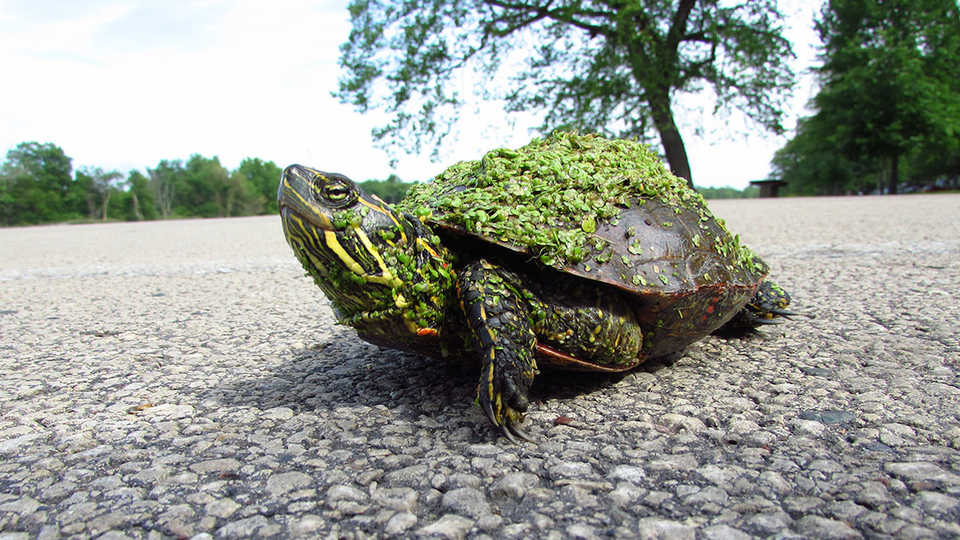Science News
Monday Bites: Honeybees, Aging Turtles, and Sleeping Dragons

Honeybee Health Update
Last month, scientists released the first comprehensive, multi-year study of honeybee parasites and disease. The results are based on a survey of beekeepers and samples from bee colonies in 41 states and two territories (Puerto Rico and Guam), spanning five seasons from 2009 through 2014. “Poor honeybee health has gained a lot of attention from scientists and the media alike in recent years. However, our study is the first systematic survey to establish disease baselines, so that we can track changes in disease prevalence over time,” says the University of Maryland’s Kirsten Traynor, lead author on the study. “It highlights some troubling trends and indicates that parasites strongly influence viral prevalence.”
The honeybee parasite receiving a lot of that attention is the varroa mite, and unfortunately, the research team found that is far more abundant than previous estimates indicated, with infestations peaking seasonally in the in late summer or early fall. Additionally, more than 50 percent of all beekeeping operations sampled had high levels of varroa infestation at the beginning of winter—a crucial time when colonies are producing long-lived winter bees that must survive on stored pollen and honey. “We knew that varroa was a problem, but it seems to be an even bigger problem than we first thought,” says co-author Dennis vanEngelsdorp. “Moreover, varroa’s ability to spread viruses presents a more dire situation than we suspected.”
“The mites are basically dirty hypodermic needles,” Traynor agrees. “The main diet for the mites is blood from the developing bee larva. When the bee emerges, the mites move on to the nearest larval cell, bringing viruses with them. Varroa can also spread viruses between colonies. When a bee feeds on a flower, mites can jump from one bee to another and infect a whole new colony.”
Of course mites and the diseases they spread aren’t the entire story in honeybee decline. “Our next step is to provide a similar baseline assessment for the effects of pesticides,” vanEngelsdorp says. “We have multiple years of data and as soon as we’ve finished the analyses, we'll be ready to tell that part of the story as well.”
Turtles Do Age!
Any paper that begins, “Why do some organisms show little to no signs of aging as they get older, whereas others exhibit substantial physiological deterioration and reproductive senescence with advancing age?” catches my eye as I reach my mid-to-late forties quite ungracefully. But turtles were always reported to avoid this mammalian fate. (Sure they look ancient as juveniles, but still…) Lucky reptiles!
But in an article appearing in today’s Proceedings of the National Academy of Sciences, Fredric Janzen and colleagues dismiss that notion. The scientists gathered birth, death and reproductive data for more than 1,000 painted turtles (Chrysemys picta) from northwest Illinois over a period of 24 years and found that the turtles do suffer senescence—a fancy word for declining reproduction and increasing mortality with advancing age. In addition, the team discovered that while total egg output tended to increase with age, the probability of successful hatching declined. In other words, the turtles age.
I guess it happens to the best of us!
Dreaming Lizards
Speaking of upending reptile stereotypes… Brain activity while sleeping was thought to be exclusive to mammals and birds, but scientists have now discovered slow-wave sleep (SWS) and rapid eye movement sleep (REMS) in the Australian bearded dragon (Pogona vitticeps). The finding, published in the current issue of Science, rewrites sleep state evolution. Instead of these sleep states evolving twice after mammals and birds diverged from reptiles, the authors suggest that they may have evolved in a common ancestor of all amniotes (tetrapod vertebrates comprising reptiles, birds and mammals), more than 300 million years ago.
But the dragons’ dream state is a bit different than ours, the authors write. “Although similar to mammalian sleep, lizard SWS and REMS resemble a stripped-down version of the richer mammalian repertoire.” The team found that lizard sleep rhythm is extremely regular and fast: the lizard’s sleep cycle is about 80 seconds long, versus 30 minutes in cats or 60–90 minutes in humans.Also, the researchers found that these brain patterns originated from the anterior dorsal ventricular ridge and not from the cortex. Overall, lizard sleep seems much simpler and may be closer to the ancestral mode of brain sleep.
Sweet dreams, sweet dragon.
Image: Aging female turtle, Clare Adams